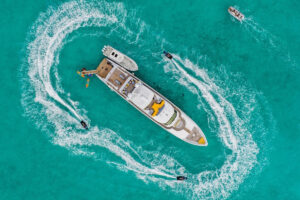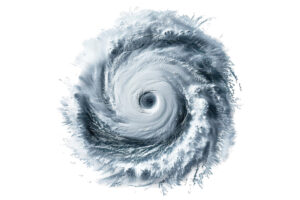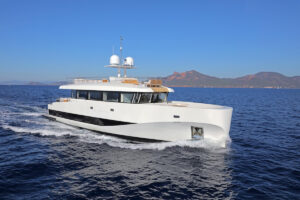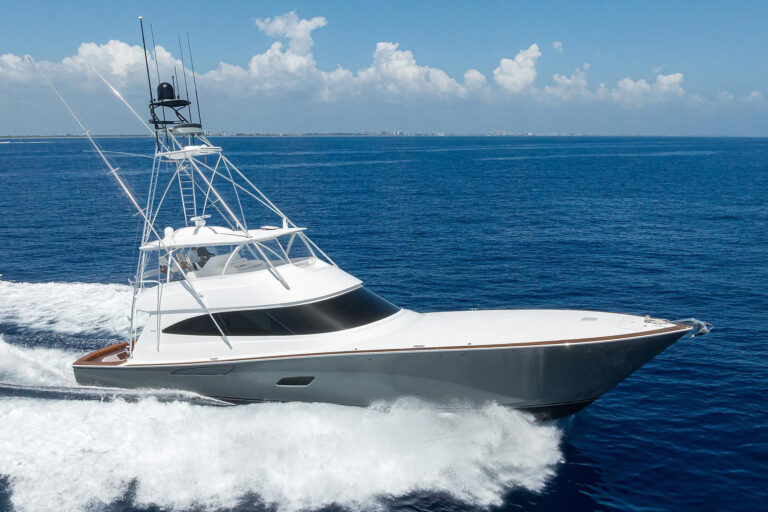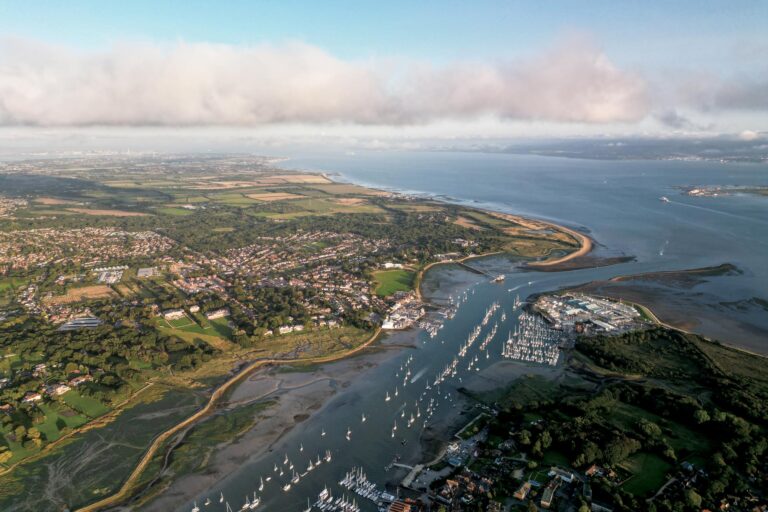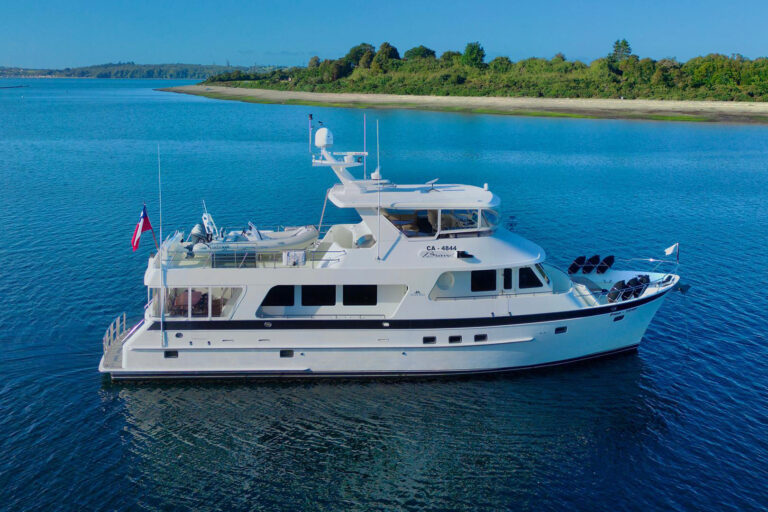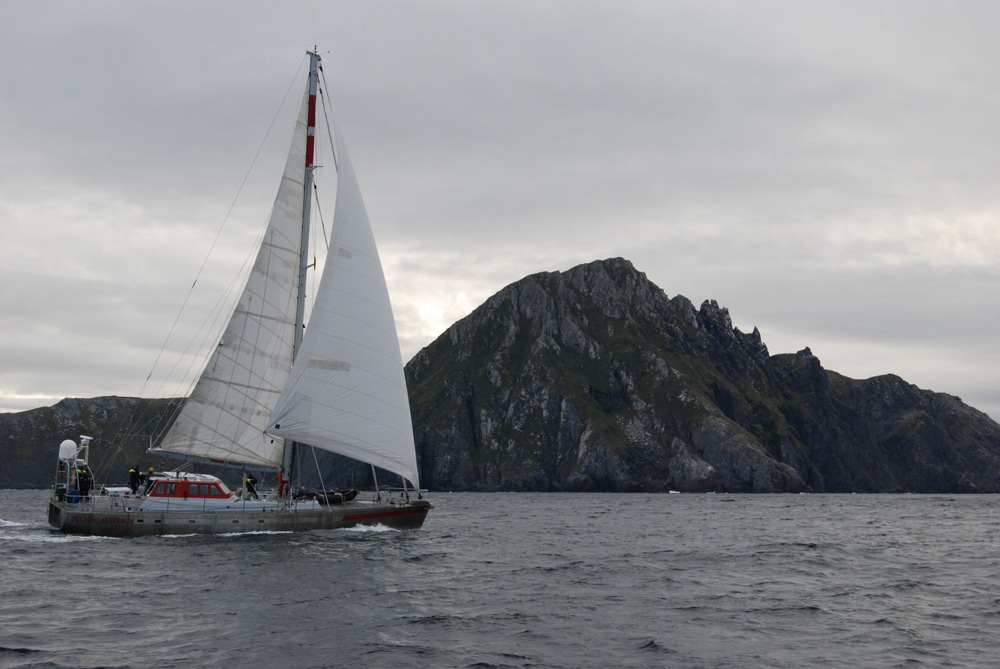
Crossing the Drake Passage
Phew, we have got safely across the Drake Passage with most of the crew intact, and the boat in one piece.
The storm that we were expecting in Antarctica delivered as promised and it was a nerve-wracking night with 60-70 knot winds blowing across the boat. We had hoped to be more sheltered from the wind, but it turned out to be westerly or even southwesterly instead of the NNW that was forecast. It was amazing watching the spray from the Gerlache Straits blowing across and completely obliterating the little island that our stern line was attached to. We had three port shore lines and they were all working extremely hard. We ran an anchor watch overnight to check for any potential chafe and try to prevent disaster if any of the lines did let go. All of us ran through the scenario in our minds, but the reality was that it was only about a boat length to the leeward shore and if the stern port line had given way, then we would have been on the rocks in seconds. Even starting the engine and sticking it into reverse would have taken too long. As you can imagine, it was a relief when, by around 10:00, the breeze had moderated to the 30s and 40s and there were less of the 50s and 60s. It’s strange to imagine how calm it can seem when you only have 35 knots after a night like that! I was on watch from 02:00-04:00 and it was pitch dark. I think I was pretty lucky as when I went on deck to check that Charlie was alright at 6am, I could see how close the leeward shore was and really watch how ferocious the winds and spray were. It had been snowing pretty hard and I think that helped make the rocks seem almost close enough to touch. The wind quickly abated and by 14:00 we were able to leave the anchorage and head north up the Gerlache Straits and through Dalman bay — the gap between Anvers and Brabant Islands — and up north towards Cape Horn and Puerto Williams.
We had the MOST wonderful display of whales on our way out of the Antarctic Peninsula area. There must have been millions of krill in the water as there were at least four separate pods of humpback whales feeding. You could see them blowing bubbles from under the water and then come rushing up, headfirst with their mouths open, completely filling their baleen with water. The water filters out leaving them with a huge delicious mouthful of the succulent pink shrimp-like krill. I took my camera up to the first spreaders to watch from there but it was a most frustrating experience. I had my zoom lens on and so was focused on such a tiny amount of water that the chances of actually seeing the animals coming up from the depths was pretty slim. Time and time again, I heard the rest of the crew ooh and aaah, and my little patch of water had remained completely undisturbed! I did get a little better at predicting where they would come up but then eventually, after taking around 200 shots of water, gave up with the camera and just watched. It really was a great treat to witness such a feast.
That first night in the Drake Passage was a shocker! The forecast was for lightish southwesterly winds and so I expected to come on watch at midnight for some boring old motoring. Instead, I discovered that the barometer had plummeted from 981 to 966 since 19:00, and the wind was a steady 30 knots. The third reef was already in, but with our first gust into the mid 30s we furled away most of the yankee. The pressure was still dropping, and it took only minutes before the gusts were hitting mid 40s and then 50s so all the yankee was quickly furled away and, since the wind was behind us, I didn’t see the point in pulling out a smaller headsail — we were doing 10 knots, in pitch darkness in a rapidly increasing wind and sea state, still in the vicinity of icebergs and I figured that was probably enough! The snow was horizontal and it was bitterly cold but I was so worried that we hadn’t put in the fourth reef (if we would even have been able to in those conditions) as the wind continued to rise that I stayed on deck watching the sail with a flashlight and hoping that nothing would give way. As the sea state rose, we began to corkscrew around on the waves and more than once I heard great crashes from below. I was relieved that it was only tools from the workshop breaking loose, and the biscuit box in the saloon making a bid for freedom and not any of the crew being flung from their bunks. Later on, while I was clearing up, another big swell hit us from the side pushing us over almost 60 degrees. At this point the galley bin opened and empty tins, plastic wrappings and some wine bottles (left over from the night before) started firing out hitting the wall opposite. It was pretty comical and I admit that I actually giggled, before swearing as two mugs, left on the galley work surface behind some bungy leaped off and smashed on the leeward side of the saloon. I have to say, I was quite relieved when Dave’s watch came on at 03:00 and I had a chance to tidy up some of the carnage and hand over responsibility for sailing the boat to another watch. By the time I went to bed, the pressure was back up to 970 and rising fast. In the morning, when it had all calmed down again, I saw from the log book that it had risen 14 millibars in three hours. In the UK where I usually sail, you wouldn’t go out to sea at all if the pressure dropped or rose by six in three hours, but down here, you can expect anything! The net pressure change overnight was plus three mb, but with a total change of 36!
Fortunately that was the worst of our crossing through the Drake Passage; the rest was a bit of a beat with winds between 18 and 35 knots, with nice big wind shifts for us to tack on. This morning — four days after leaving the whales down on the peninsula — we crossed over onto the continental shelf just south of Cape Horn. As we approached land the swell was still running pretty big but the wind was dropping by the minute. Unfortunately, on one of the very last big rolls, one of the guests fell across the pilot house and crushed his ribs. We are afraid that they may well be broken so we will be taking him to the hospital in Puerto Williams when we arrive there tomorrow.
As we approached Cape Horn, the wind and the swell continued to ease. I was told that my watch was feeling horny — being the only girl on board, this worried me somewhat, until clarified : Cape Horny! Everyone was awake to witness the passing of this great cape, one of the most significant landmarks on any sailor’s atlas, and it gave Miles an opportunity to ask how many people would like to try and land on Cape Horn Island and visit the lighthouse keeper there. Unsurprisingly, there was unanimous agreement that this was a fantastic plan and the Zodiac was reinstated on the foredeck in minutes by our incredibly efficient Russian team. I spoke in my best Spanish (well, ok, Spanglish) to the lighthouse keeper and we were given permission to land. Miles and seven of the eight guests piled into the Zodiac, made a safe landing on the beach and spent a very happy hour or two admiring the great Cape, the lighthouse, the world famous Albatross sculpture, the chapel, drinking champagne, getting their passports stamped and signing the visitors’ book — a pretty special opportunity for anyone, but especially welcome after such disappointing weather and limited opportunities down in Antarctica.
Now, we are at anchor in Bahia Scourfield, on Isla Woolaston, just north of Cape Horn but in the same group of islands. It was a beautiful still afternoon and in such a stunning setting, that I suggested that we ought to take the plunge and have a swim. Unfortunately, Dave took me up on the challenge and after a certain amount of peer pressure and bullying, I reluctantly jumped in after him. The water is 11 degrees Celsius — so much, much warmer than in Antarctica, but still cool enough to get the heart beating and the breath coming in quick short bursts. It was a fantastic feeling, and a great excuse for a hot shower afterwards! We don’t have a water-maker on board, so we have to be pretty careful with water, but this was apparently a legitimate excuse.
Tomorrow we head up to Puerto Williams, and it will be a great relief to be safely tied up alongside the Micalvi with all our exciting and dramatic Antarctic experiences behind us for this year. A quick turn around before our next guests arrive and it probably won’t be more than a couple of weeks before we are attempting again to land on Cape Horn with our group of Australians. Before that, though, there is the challenge of reprovisioning the boat in Puerto Williams where there are very limited shopping opportunities. Fingers crossed that the email I sent to Punta Arenas has got through and that our order is all being sent to us from there by ferry in time for the next group’s arrival. I’ll keep you posted!
-Laura and Miles

